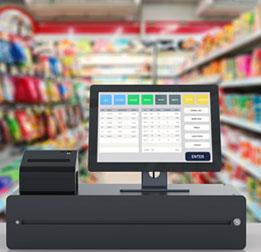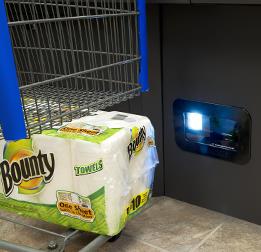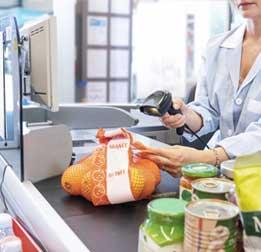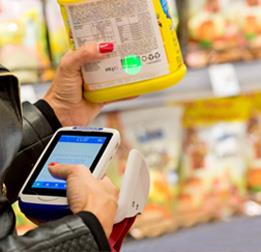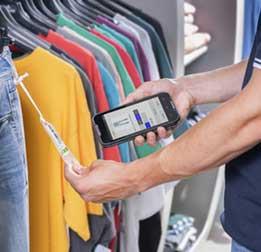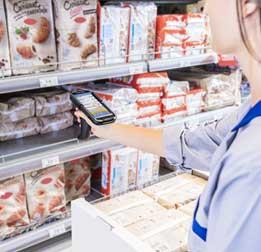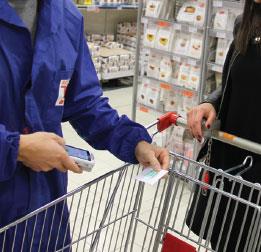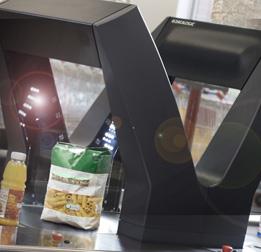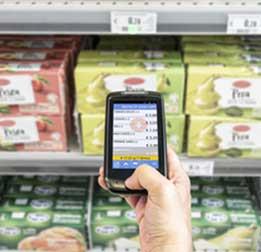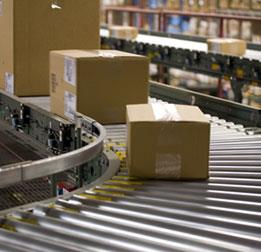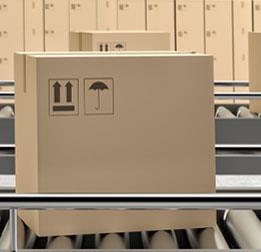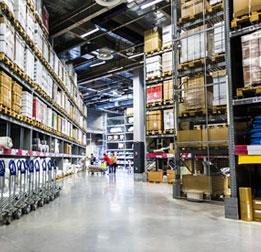
Retail
Retail
To support you in making your customers happy, we have developed a full set of retail solutions. They aim to help you in finding solutions that fit your needs. With all kind of different buzz words floating around such as: online shopping, self-checkout, self-shopping, click and collect, etc. it might sometimes appear difficult to define needs and solutions. For this reason, we are here to help you with a comprehensive range that offers you the flexibility to choose products that match your individual requirements. Our Handheld Scanners, Fixed Retail Scanners, Mobile Computers, Stationary Industrial Scanners and RFID Systems accompany you and your users alongside your full supply chain. With the widest range in the market we enable you to cover all your needs from one source. Datalogic technology ensures the flawless moving of your products from the point of arrival up to your store or your customer. They are helping you to manage all customer orientated tasks such as assisted sales and shelf replenishment and at the same time turn into self-shopping pods in the hands of your customers. Whether your POS is assisted or organized as a self-checkout, you can be sure that our fixed retail scanners make the experience for your customer fast and reliable. At the same time, you will not have to worry about what is happening in your warehouse, as our vehicle mount computers secure every moving good, while our stationary scanners guide the sorting systems in distribution centers. All our products and systems are available in different versions to capture all bar code symbols including 1D and 2D barcodes, Digimarc™ digital watermark codes and Direct Part Marking (DPM). Being the first company to scan a barcode on a chewing gum in a grocery store in 1974, all our experience is shared with you in each of your retail solution projects.
RETAIL SOLUTIONS FROM DATALOGIC
The retail ecosystem consists of different areas, where speed, accuracy and seamless traceability are the key to customer satisfaction. Online sales have added a new challenge to this ecosystem as today every system needs to be capable to manage this type of sales and at the same time ensure an efficient return management. On top customers are more and more demanding and technology must ensure flexible in-store solutions to ensure customer satisfaction and loyalty. The benefit you get from the wide Datalogic portfolio is that it overlooks your full ecosystem. Whether you deal groceries, or you handle non food articles, whether you are an e-commerce retailer or managing brick- and-mortar stores, the Datalogic portfolio supports all your barcode reading applications.
Datalogic retail solutions have been designed to help you in being more efficient and make shopping easy and satisfactory for your customers – no matter where and how they shop.
BENEFITS CUSTOMERS GET FROM RETAIL SOLUTIONS
- In-Store Checkout POS
In-store Point of Sales (POS) systems are essential for retail stores as they streamline the checkout process and improve the shopping experience for customers. Various types of POS systems are available in the market, including self-checkout solutions, checkout POS, and mobile POS. This article discusses the different types of POS systems and their benefits in detail.
- Solutions for Retail Store Operations
The words retail store operations encase all the activities carried out at the physical store, ranging from customer service tasks to administration and management responsibilities. The amount and setup of the individual operations vary from store to store, depending on the company’s organizational layout and business goals.
- Warehouse & Fulfillment Centers
In today's fast-paced world, warehouse and fulfillment centers play a vital role in the supply chain of any organization. With the increasing demand for speedy delivery and efficient inventory management, warehouse solutions incorporating automated technology have become a necessity.
- Distribution Center and Warehouse
In the complex world of retail logistics, the distribution center warehouse plays a pivotal role in maintaining a steady flow of goods from suppliers to retail stores. Keeping retail stores stocked with products requires a robust logistics system to ensure the continuous flow from distribution centers to retail stores. This requires scan-intensive applications where ruggedness and reliability are paramount.
Download Retail Industry Guide
Applications
In-Store Checkout POS
In-store Point of Sales (POS) systems are essential for retail stores as they streamline the checkout process and improve the shopping experience for customers. Various types of POS systems are available in the market, including self-checkout solutions, checkout POS, and mobile POS. This article discusses the different types of POS systems and their benefits in detail.
SELF-CHECKOUT SOLUTIONS
Self-checkout solutions are becoming increasingly popular among grocery stores and retail stores. They offer customers the convenience of skipping the service checkouts and completing the checkout process themselves. Self-checkout POS terminals usually consist of a touchscreen display, a barcode scanner, and a payment terminal. Customers can scan the items they wish to purchase, and the POS system will calculate the total amount due. Customers can then pay using cash, credit/debit card, or mobile device.
Self-checkout solutions have many benefits for retail stores. They reduce waiting times at the service checkouts, thus improving the customer experience. Moreover, they allow retail stores to save on labor costs as fewer employees are needed to manage the checkout process. Self-checkout systems also offer additional service options such as bagging stations, which customers can use to pack their purchased items.
CHECKOUT POS
Checkout POS systems are the most common type of POS system used in retail stores. They consist of a computer terminal and a barcode scanner and are usually connected to a cash drawer and receipt printer. Checkout POS systems can be used to process transactions, manage customer data, and run loyalty programs.
Checkout POS systems have many benefits for retail stores. They are easy to use and can process transactions quickly, reducing waiting times for customers. Checkout systems can also be integrated with inventory management systems, allowing retail stores to track their inventory levels in real-time. Moreover, they can be used to run loyalty programs, which can help to increase customer retention.
RETAIL OPERATION
Retail operation is the backbone of any retail store. It involves managing various tasks such as inventory management, customer data management, and transaction processing. Retail POS systems are designed to help retail stores manage these tasks efficiently. They provide real-time information on inventory levels, sales data, and customer data, which can be used to make informed business decisions.
INVENTORY MANAGEMENT SYSTEMS
Inventory management systems are essential for retail stores as they help to keep track of inventory levels in real-time. Inventory management systems can be integrated with POS systems, allowing retail stores to automatically update their inventory levels whenever a transaction is processed. This ensures that retail stores always have accurate information on their inventory levels, which can help to prevent stockouts and overstocking.
CHECKOUT POINT OF SALES (POS) SYSTEMS
Checkout POS systems are designed to streamline the checkout process for customers. They are easy to use and can process transactions quickly, reducing waiting times for customers. Checkout POS systems can also be integrated with inventory management systems thanks to powerful OS software, allowing retail stores to track their inventory levels in real-time. Moreover, they can be used to run loyalty programs, which can help to increase customer retention.
SELF-CHECKOUT POS TERMINALS
Self-checkout POS terminals are designed to be the best of both worlds, offering retail store customers the ability to tailor their shopping experience, and generally avoid waiting in long lines at the checkout. Modern OS software allows for easy integration between the stand-alone and retail store inventory management systems. Furthermore, when coupled with other technologies such as camera systems, self-checkouts can help speed up the process and avoid loss prevention.
In conclusion, in-store POS systems are essential for retail stores as they streamline customer checkout and improve the shopping experience for customers. Self-checkout solutions, checkout POS, and mobile POS are the most common types of POS systems used in retail stores. They offer many benefits such as reduced waiting times, real-time inventory management, and improved customer data management.
Datalogic has unparalleled leadership in reliable checkout POS and self-checkout solutions that enable retailers to enhance checkout speed as well as improve transaction accuracy and efficiency.
To support the different configuration needs at the checkouts, Datalogic offers an extensive line of technology solutions such as 100% digital imaging scanners with integrated scale (optional), presentation scanners, handheld scanners, self-shopping systems, mobile POS devices, and much more.
Solutions for Retail Store Operations
WHAT DOES “RETAIL STORE OPERATION” SOLUTIONS EXACTLY MEAN?
The words retail store operations encase all the activities carried out at the physical store, ranging from customer service tasks to administration and management responsibilities. The amount and setup of the individual operations vary from store to store, depending on the company’s organizational layout and business goals.
We will start addressing the main retail store operation solutions and the way to improve them, and finally, we will introduce the dedicated products and services provided by Datalogic.
THE MAIN RETAIL STORE OPERATION SOLUTIONS
Based on the size, a retail business can organize operations in distinct, hierarchical departments, or make them fall under a single, versatile unit. The overall scope of the company is not the only factor determining the layout of the operations; another one is the nature of the business itself. In fact, if retail usually implies the providing of “goods or services,” today’s market is flooded with many hybrid instances, which include the sale of both products and services at the same location. This is especially evident when we cross over into the field of e-commerce, which has its own specific pathway to set, execute and manage retail store operation solutions.
Whether physical or online, the main retail store operation solutions are the following:
- Design. A remarkable shopping experience starts from the store’s aesthetics. You can think of design as the brand/store personality expressed through the store location, the department organization, the visual display of merchandise, the atmosphere created by lighting, music, perfume, etc.
- Customer service. Customers’ satisfaction is the litmus test of a retail business's health. When store managers focus on delivering a positive, personalized customer service experience, the competitiveness of their business can easily skyrocket, making them strong enough to challenge even the biggest competitors.
- Cash, fraud, and internal controls. Store staff needs to thoroughly look after safety and security in the shop, by monitoring the handling of cash and credit cards, preventing shoplifting and fraud, and defining shared, data-driven procedures for internal controls.
- Product inventory. Inventory management is the fourth, essential retail operation. Balancing the supply and demand flux as well as the selling and restocking of an ever-changing park of products is a complex task for most stores. Furthermore, the current abnormalities suffered by supply chain operations have contributed to making things even harder. For this reason, retail stores need to adopt automated inventory management solutions to face the challenges ahead.
- Administration. Managing store premises, promotions and events, training of employees as well as data management are all activities falling under administration duties. Owning an automated management system can help scale down the number of tasks in need of real-time supervision.
- Store management. Keeping the daily flow of operations uninterrupted is the top priority and responsibility of store management. Additionally, store managers need to execute comprehensive strategies and directives coming from regional or corporate managers, effectively acting as a bridge between the shop and the head management.
Responsibilities may include:
- Hiring, firing, training, and managing employees
- Forecasting sales and budgeting
- Oversight of inventory and loss prevention
- Oversight of all internal controls, such as cash handling
- All aspects of customer service
- Internal and external communication
- Legal compliance
HOW CAN RETAIL OPERATIONS BE IMPROVED?
When efficiency drives retail store operations, companies can even exceed the forecasted return on investment. Operations in the retail industry can be improved in the presence of an all-around strategy encompassing multiple areas within the physical store. Store managers must design the shopping experience around customer satisfaction if the retail business is to thrive.
To help you set up your own plan, we put together a list of hints and suggestions to improve your retail operations.
- Use your customers’ unique information to push for a valuable, data-driven upsell.
- Enhance your inventory management, get a Point-of-Sale system that is connected with your online inventory in real-time.
- Collect your customers’ email addresses and set an email marketing strategy to lay the groundwork for customer retention.
- Magnify your CRM to keep a record of your customers' purchases to create customized promotions and deliver a personalized customer experience.
- Leverage stores as a point of contact to customers, extending the online services, customer support and proximity presence.
- If you are considering expanding your business online, a 3PL (third-party logistics) can be extremely helpful in scaling up your e-commerce.
DATALOGIC SOLUTIONS FOR RETAIL STORE OPERATIONS
Datalogic is a worldwide retail leader for 40 years. Datalogic has solutions for retail store operation are targeting the whole retail supply chain, including full digital imaging devices, automated scanning portals, mobile computers, and handheld scanners. Our solutions for the retail industry aim at enhancing customer experience at the physical store and easing store staff activities with data-driven solutions.
Self-shopping
Grocery check-out
- QuickScan 2500 Series
- PowerScan 9500 Retail Series
- Magellan Bioptic series (i.e., 9800i, 9400i, 9300i)
- Magellan 1500i
- Joya Touch
- Gryphon 4500 Series
Product & pricing management
Inventory management
Shelf replenishment
Queue busting
Warehouse & Fulfillment Centers
WAREHOUSING AND LOGISTICS
In today's fast-paced world, warehouse and fulfillment centers play a vital role in the supply chain of any organization. With the increasing demand for speedy delivery and efficient inventory management, warehouse solutions incorporating automated technology have become a necessity. By the time a product is placed on a store shelf, it has traveled countless miles and has been handled by many people. Making sure the right product gets to the right store at the right time requires technology along the whole supply chain.
Automated technology such as mobile computers, barcode scanners, and other Datalogic hardware solutions can help increase productivity, reduce costs, and optimize warehouse management. These solutions not only streamline inventory management but also increase inventory accuracy, resulting in reduced inventory shrinkage.
WAREHOUSE CENTERS SOLUTIONS
One solution includes mobile computers, which are handheld devices used for real-time data collection. These devices can help warehouse workers scan barcodes, update inventory records, and manage order fulfillment. With mobile computers, warehouse workers can access real-time data, improving their decision-making capabilities and making their work more efficient.
Barcode scanners are another crucial piece of technology in warehouse and distribution centers. These devices use laser or imaging technology to read barcodes, helping workers quickly identify inventory and update records. Barcode scanners can help reduce manual errors and increase inventory accuracy, leading to improved order fulfillment and customer satisfaction.
A manual data collection is also a useful tool in warehouse management. This method involves manually tracking inventory using pen and paper. While this method may seem outdated, it can be helpful in situations where automated technology is not available or not feasible. For example, manual data collection can be used to track inventory in areas where barcode scanners are not accessible or to perform cycle counts on specific items.
Datalogic provides many useful solutions in warehouse and distribution centers. This technology uses image recognition software to identify and track inventory, making it easier to manage and optimize warehouse storage space. Datalogic mobile computers can help reduce costs by providing accurate inventory data, allowing organizations to better manage their inventory levels and reduce the need for overstocking.
Optimizing warehouse storage space is crucial in warehouse management. This not only helps reduce costs but also ensures that inventory is easily accessible and efficiently stored. With the use of automated technology, warehouse workers can track inventory levels in real-time and identify areas where space can be better utilized. This can lead to improved inventory management and increased productivity in the warehouse.
Distribution centers can also benefit from the use of automated technology. With outbound logistics, it is essential to have accurate inventory data to ensure that orders are fulfilled correctly and on time. Automated technology such as barcode scanners and mobile computers can help improve order fulfillment accuracy and speed, leading to increased customer satisfaction.
Inbound logistics is another area where warehouse solutions incorporating automated technology can be useful. With the use of barcode scanners from Datalogic, workers can quickly and accurately receive inventory, reducing the time it takes to process incoming shipments. This can help increase productivity and ensure that inventory is available when needed.
Inventory management is a crucial part of warehouse and fulfillment center operations. With the use of automated technology, inventory accuracy can be improved, reducing inventory shrinkage and increasing inventory turnover. This can lead to reduced costs and increased revenue for the organization.
In conclusion, warehouse and fulfillment centers are critical components of the supply chain for any organization. With the use of automated technology such as mobile computers, barcode scanners, and other great products from Datalogic, warehouse management can be optimized, leading to increased productivity, reduced costs, and improved customer satisfaction. Whether managing inventory, order fulfillment, inbound logistics, or outbound logistics, the use of automated technology can help organizations stay competitive in today's fast-paced business environment.
Please see for more information on each of Datalogic’s products and services to assist your warehouse and fulfillment operation.
Distribution Center and Warehouse
THE ROLE AND FUNCTION OF THE DISTRIBUTON CENTER AND WAREHOUSE IN RETAIL LOGISTICS
In the complex world of retail logistics, the distribution center warehouse plays a pivotal role in maintaining a steady flow of goods from suppliers to retail stores. Keeping retail stores stocked with products requires a robust logistics system to ensure the continuous flow from distribution centers to retail stores. This requires scan-intensive applications where ruggedness and reliability are paramount.
A distribution center warehouse is a strategic hub in the retail supply chain where products are received, stored, and shipped to numerous retail locations. Key functions of these centers include order processing, transportation management, and inventory management, all of which are critical in ensuring that products reach their intended retail locations in a timely and efficient manner.
ORDER PROCESSING AND TRANSPORTATION MANAGEMENT
Order processing is a core function of the distribution center. It involves managing customer orders, including receiving, picking, packing, and final shipping to appropriate retail locations. This process is often facilitated by advanced technologies such as Datalogic mobile computers and industrial barcode readers and scanners, helping ensure accuracy and efficiency in order processing.
Transportation management, another central function of the distribution center, involves coordinating the movement of goods from the warehouse to retail locations. This includes planning and optimizing routes and schedules to guarantee on-time delivery and minimize transportation costs.
WAREHOUSE VS DISTRIBUTION CENTER AND PRODUCT MIXING
It is crucial to distinguish between a traditional warehouse and a distribution center. While both store goods, their operations differ significantly. Traditional warehouses focus primarily on long-term storage, storing products in large quantities for extended periods of time. On the other hand, distribution centers are designed for short-term storage and high volume order processing. Products are received, stored for a short-term, and shipped quickly to fulfill customer orders.
Product mixing is another essential function of distribution centers. They receive products in large quantities that are then broken down into smaller quantities for shipment to retail locations. This is especially useful when a retail location needs a variety of products but in smaller quantities than the manufacturer's minimum shipment size.
STORAGE SPACE AND INVENTORY MANAGEMENT
Despite their focus on short-term storage, distribution centers still require significant storage space. They must be able to handle high volumes of goods, particularly during peak periods. However, distribution centers focus heavily on inventory management instead of simply storing products. This involves tracking the quantities and locations of products in the warehouse to ensure accurate order fulfillment and to inform reordering decisions.
THE FULFILLMENT CENTER AND ITS ROLE
While a distribution center primarily stores products for retail locations, a fulfillment center is designed to deliver products directly to customers. Fulfillment centers specialize in handling individual customer orders, often for online retailers. However, both types of centers use similar technologies, such as industrial barcode readers and scanners, to ensure accuracy and efficiency in their operations.
THE BOTTOM LINE
In summary, the distribution center warehouse is integral to the retail logistics system. By efficiently handling order processing, transportation management, and inventory management, distribution centers keep products moving and ensure that retail stores have the goods they need. As retail logistics continue to evolve, the role of the distribution center will become even more important, underscoring the need for continuous innovation and improvement in these vital facilities.
Success Stories
Video Gallery
Datalogic Solutions for Distribution Centers
DPD and Datalogic for reliable package tracking
Datalogic supplies 200 scanners to "Best Retail Chain in Belgium"...



